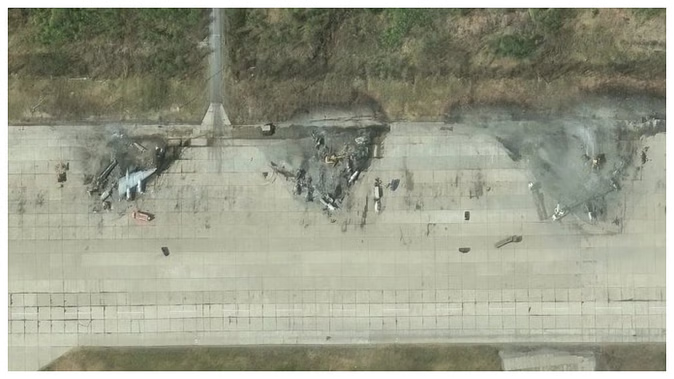Russia Faces Major Setback as Satellite Images Reveal Damage from Ukrainian Drone Strikes on Key Airbases
Moscow/Kyiv – New satellite imagery has revealed the extent of destruction caused by Ukraine’s recent drone strikes on Russian airbases, exposing significant damage to military infrastructure and aircraft. The attack, reportedly conducted under Ukraine’s covert “Operation Spider Web,” marks a major escalation in the ongoing conflict and a significant tactical blow to the Russian Air Force.
Satellite photos of Belaya Air Base in Siberia’s Irkutsk region and Olenya Air Base in Murmansk, located in the Arctic zone, show widespread devastation. The imagery clearly displays wreckage of aircraft strewn across runways and hangars, as well as significant damage to support infrastructure. The debris of Russia’s strategic bombers, including the TU-95 and TU-22M, can be seen scattered across the airfields.
According to Ukrainian military sources, a total of five Russian airbases were targeted in the multi-pronged drone assault. While satellite visuals from only two bases—Belaya and Olenya—have been released due to heavy cloud cover over the others, images from Ivanovo Severny, Dyagilevo, and Ukrainka Air Base are expected to be available soon. Each of these bases lies deep within Russian territory, with Ukrainka located nearly 8,000 kilometers from the Ukrainian border, and Belaya approximately 4,500 kilometers away.
High-Value Russian Aircraft Destroyed
The attacks specifically targeted Russia’s high-value strategic bombers and surveillance aircraft. The TU-95, a four-engine turboprop bomber capable of carrying nuclear weapons, and the TU-22M, used for long-range strikes, were among the aircraft confirmed destroyed. Additionally, at Ivanovo Severny Airbase, Ukrainian drones successfully destroyed at least one A-50 AWACS aircraft—a critical component in Russia’s early warning and airborne command system.
The destruction of the A-50, a flying radar station, significantly weakens Russia’s ability to monitor Ukrainian air movements and conduct coordinated long-range operations. This precision strike underscores Ukraine’s growing capability to hit high-value military targets deep inside Russian territory.
Visual Evidence of Devastation
In the satellite images of Belaya Air Base, wrecked TU-95 bombers are visibly charred, some reduced to twisted metal. One image shows a formation of aircraft that appear to have been lined up on the runway—now reduced to rubble. Though Russia has reportedly begun clearing the wreckage, experts estimate that at least 10 aircraft may have been destroyed at this location alone.
Olenya Air Base, which is crucial for Russian operations in the Arctic, also appears heavily damaged. Multiple aircraft can be seen damaged or destroyed, though the extent of the loss is still being assessed.
Strategic and Political Implications
The effectiveness and depth of Ukraine’s drone campaign signals a bold new phase in the war, one where long-range drone warfare is taking center stage. By striking deep into Russian territory, Ukraine has demonstrated its enhanced intelligence and technological capabilities, likely supported by Western surveillance and satellite data.
Following the attacks, a significant diplomatic development also took place. According to reports, Russian President Vladimir Putin and former U.S. President Donald Trump held a one-hour phone call. During the conversation, President Putin allegedly vowed retaliation for the attacks, signaling a potential intensification of the conflict in the days ahead.
The Russian Ministry of Defense has yet to provide a full official statement detailing the losses. However, defense analysts suggest that the destruction of strategic bombers and surveillance aircraft will hinder Russia’s aerial dominance, at least temporarily.
What’s Next?
While Ukraine has not officially confirmed its role in the drone strikes, the evidence from satellite imagery and tactical outcomes strongly suggests a coordinated offensive. Military experts believe this could mark the beginning of a new strategy focused on crippling Russia’s long-range air capability before potential summer offensives.
Further satellite images of the remaining three targeted airbases—Ivanovo Severny, Dyagilevo, and Ukrainka—are anticipated in the coming days, which may provide an even clearer picture of the operation’s full impact.
As both nations brace for the next phase of this prolonged war, the recent drone strikes underscore Ukraine’s evolving military sophistication and Russia’s increasing vulnerability—even far from the front lines.
